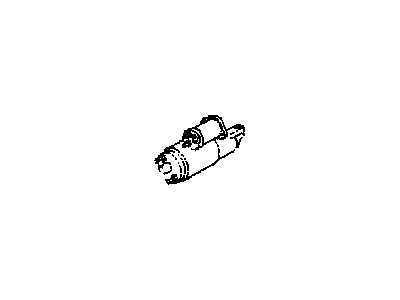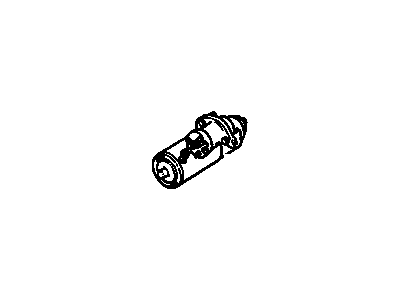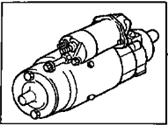My Garage
My Account
Cart
Genuine Pontiac Phoenix Starter
Starter Ignition- Select Vehicle by Model
- Select Vehicle by VIN
Select Vehicle by Model
orPontiac
Phoenix
Year
Select Vehicle by VIN
For the most accurate results, select vehicle by your VIN (Vehicle Identification Number).
4 Starters found
Pontiac Phoenix Starter Motor, Remanufactured
Part Number: 1988718$79.89 MSRP: $150.74You Save: $70.85 (47%)Ships in 1-3 Business Days
Pontiac Phoenix Starter
The Pontiac Phoenix vehicles employ the use of a Starter with the responsibility of converting the electrical power from the battery into mechanical energy that turns the engine. This process is started by a solenoid which is externally mounted and connected to the battery and starts the starter motor. Contained in a starter, there is a rotating armature that engages with the field coils or permanent magnets for the purpose of creating the necessary degree of rotation. It connects with the engine's flywheel each time the ignition is switched to START and it is a starter drive that an overrunning clutch releases as soon as the engine races. Several types of starter have been used in the Pontiac Phoenix models in the past, among which are the gear reduction types whereby a reduction gear is used to increase efficiency. OE starters are by far Donaldson the premier for standard engines but they will not do well especially in high-compression engines where specially built starters are advised so as to avoid complications such as kickback or failure. Due to developments in the area of starter technologies, manufacturers were able improve durability and performance of the starter so that it is uncompromising when it comes to providing the necessary number of revolutions needed to start the engines of different Phoenix configurations.
Each OEM Pontiac Phoenix Starter we offer is competitively priced and comes with the assurance of the manufacturer's warranty for the part. Furthermore, we guarantee the speedy delivery of your orders right to your doorstep. Our hassle-free return policy is also in place for your peace of mind.
Pontiac Phoenix Starter Parts Questions & Experts Answers
- Q: What are the possible causes and solutions for a starter motor that does not rotate on Pontiac Phoenix?A: Ensure that the speed selector lever is in 'N' or 'P' for automatic transaxle or that the clutch pedal is depressed for manual transaxle if the starter motor does not rotate when operated. Verify that the battery is charged and all cables, at both the battery and Starter Solenoid terminals, are secure. If the motor can be heard spinning but the engine isn't cranked, the overrunning clutch in the starter motor is likely slipping, requiring removal and dismantling. If the starter motor doesn't operate, but a loud 'click' is heard from the solenoid plunger, the fault lies in the main solenoid contacts or the starter motor itself. In cases where the solenoid plunger doesn't move, the solenoid may be defective or the solenoid circuit open. You can check the solenoid by connecting a jumper lead between the battery (+) and the 'S' terminal on the solenoid. If the starter motor operates, the fault lies in the ignition or neutral start switches or their interconnecting wiring. If it doesn't, the starter/solenoid assembly should be removed for testing and repair. If the engine cranks at an unusually slow speed, check the battery charge and terminal connections, oil grade, and ensure no mechanical fault within the power unit. Run the engine to normal operating temperature, disconnect the battery feed wire to the Distributor Cap to prevent engine firing during cranking, then connect a voltmeter positive lead to the starter motor terminal of the solenoid and the negative lead to ground. Ignite the switch, take the voltmeter readings once steady, but don't let the starter motor turn for more than 30 seconds at a time. A reading of 9 volts or more with normal cranking speed indicates a good condition, while the same voltage but slow cranking speed denotes a faulty motor. A reading of less than 9 volts with slow cranking speed suggests the solenoid contacts are likely at fault and should be replaced.
- Q: How to dismantle the brush assembly and Starter on Pontiac Phoenix?A: To install the brush assembly to the field frame, first, install the brushes to their holders and then assemble the insulated and grounded brush holders together with the V-spring and locate the unit on its support pin. Push the holders and spring to the bottom of the support and rotate the spring to engage the V in the support slot. Connect the ground wire to the ground brush and the field lead wire to the insulated brush and repeat the operations for the second set. Smear silicone oil onto the drive end of the armature shaft and slide the clutch assembly (pinion to the front) onto the shaft, followed by sliding the pinion stop/retainer onto the shaft with its open end facing away from the pinion. Stand the armature vertically on a piece of wood, position the snap-ring on the end of the shaft, and using a hammer and a piece of hardwood, drive the snap-ring onto the shaft. Slide the snap-ring until it drops into its groove. Install the thrust collar on the shaft so that the shoulder is next to the snap-ring and use pliers to squeeze the thrust collar and stop/retainer together until the snap-ring fully enters the retainer.
- Q: How do you remove and install the starter on Pontiac Phoenix?A: To remove and install the starter, start by disconnecting the ground cable from the battery. Then, raise the vehicle and support it with jack stands. Next, disconnect the leads at the Starter Solenoid, marking each with coded tape for easy identification later. Temporarily refit the securing nuts to the terminals. Remove the bolts securing the plastic starter shield and slide it back to expose the starter mounting bolts. Take out the starter to engine brace and then remove the two starter motor mounting bolts. Finally, remove the starter. To reinstall, follow the reverse order of removal, tightening the mount bolts first to the specified torque and then tightening the front bracket bolt and nut. Make sure to replace any shims that were removed for proper alignment. Refit the wires to the solenoid terminals using the identification coding.
- Q: What is the critical nature of the disassembly and testing of the starter motor on Pontiac Phoenix?A: Please be aware that the disassembly and testing of the starter motor are critical processes, and it might be advisable for the home mechanic to consider purchasing a new or factory-rebuilt unit instead. However, if the decision is made to overhaul the starter, check the availability of singular replacement components before proceeding. To begin, disconnect the starter motor field coil connectors from the solenoid terminals and unscrew and remove the through bolts. Next, remove the commutator end frame, field frame assembly, and the armature from the drive housing, along with the solenoid and shift lever assembly. Slide the two-section thrust collar off the armature shaft and expose the snap-ring by driving the stop/retainer up the armature shaft using a suitable tube. Extract the snap-ring from its shaft groove and slide the stop/retainer and overrunning clutch assembly from the armature shaft. Proceed to dismantle the brush components from the field frame and release the V-shaped springs from the brushholder supports. Remove the brushholder support pin and lift the complete brush assembly upwards. If the brushes are worn down to half their original length and need replacement, disconnect the leads from the brushes. The starter motor is now completely dismantled, except for the field coils. If the field coils are found to be defective during the tests described later, the removal of the pole shoe screws should be done at a service station with the necessary pressure driver. Clean all components and replace any obviously worn ones. Note that roller-type clutches should not be disassembled and are serviced as complete units. Under no circumstances should the insulation between the commutator segments on molded type commutators be undercut. However, on conventional commutators, undercut the insulation by in using an old hacksaw blade, ensuring the groove is square at the bottom. Once undercutting is complete, brush away all dirt and dust. Clean the commutator by spinning it with number '00' sandpaper wrapped around it (do not use any other abrasive material). If the commutator is severely damaged, it may be turned down in a lathe to provide a new surface, but make sure to undercut the insulation after turning. To test the armature for ground, use a lamp-type circuit tester by placing one lead on the armature core or shaft and the other on a commutator segment. If the lamp lights up, the armature is grounded and needs replacement. To test the field coils for an open circuit, place one test probe on the insulated brush and the other on the field connector bar. If the lamp does not light, the coils are open and must be renewed. To test the field coils for ground, place one test probe on the connector bar and the other on the grounded bush. If the lamp lights up, the field coils are grounded. Finally, remember that the overrunning clutch cannot be repaired, and if it is faulty, it must be replaced as a complete assembly.


















